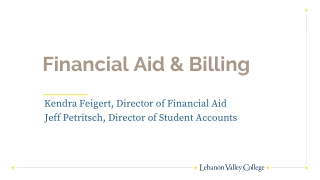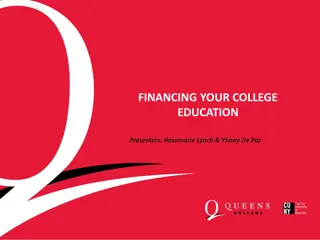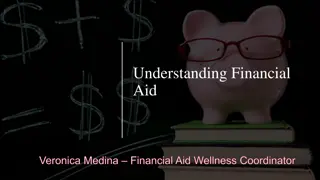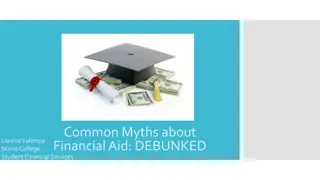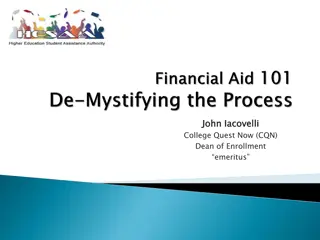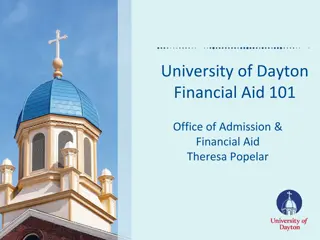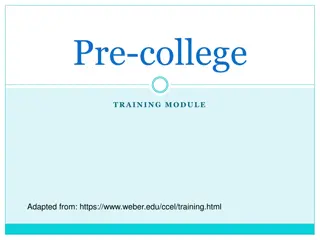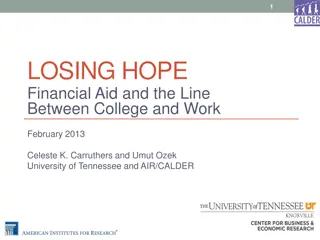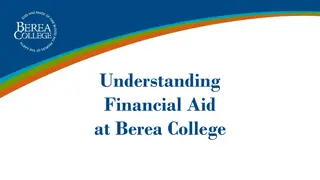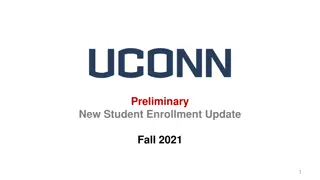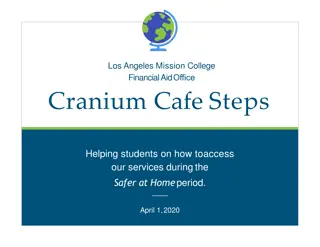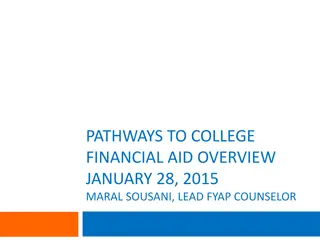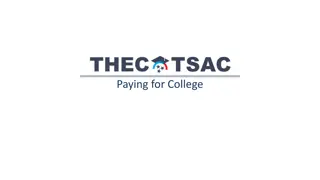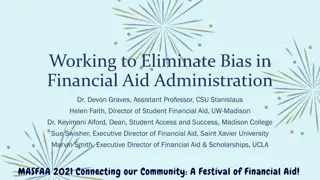Financial Aid Overview for College Students
Financial aid is money provided by sources other than the family to help cover college costs. Explore different types like grants, scholarships, loans, and work-study programs. Learn about federal, state, and private sources of financial aid and how to apply for it.
Download Presentation

Please find below an Image/Link to download the presentation.
The content on the website is provided AS IS for your information and personal use only. It may not be sold, licensed, or shared on other websites without obtaining consent from the author.If you encounter any issues during the download, it is possible that the publisher has removed the file from their server.
You are allowed to download the files provided on this website for personal or commercial use, subject to the condition that they are used lawfully. All files are the property of their respective owners.
The content on the website is provided AS IS for your information and personal use only. It may not be sold, licensed, or shared on other websites without obtaining consent from the author.
E N D
Presentation Transcript
Welcome to Financial Aid Night 2024-2025 Academic Year Matt Pfannenstiel Associate VP of Enrollment McPherson College
What is financial aid? Categories, Types, Sources Free Application for Federal Student Aid (FAFSA) FAFSA Simplification Changes FSA ID SAI (Student Aid Index) Topics for Tonight Next steps
What is Financial Aid? Money supplied by a source other than the family to assist with the costs of a student attending college Types of Financial Aid Grants Scholarships Loans Work Study
Grants Free money or Gift Aid Federal Grants Supplemental Grants Does not have to be repaid Often based on financial need
Scholarships Free money or Gift Aid Does not have to be repaid Based on academic achievement, merit, athletic ability, skills, etc.
Loans Money that students and parents borrow to help pay for college Repayment usually begins after education is finished (typically 6 month grace period)
Employment (Work Study) Allows students to earn money to help pay educational costs Paycheck Non-monetary compensation such as room and board
Sources of Financial Aid Federal Government States Colleges Private Sources Civic Organizations and Churches Employers
Federal Government Largest source of aid Aid awarded primarily on the basis of need Must apply EVERY YEAR using the FAFSA
States Residency Requirement Award aid on the basis of both merit and financial need Uses FAFSA info Deadlines vary by state (April 1)
Private Sources Foundations, businesses, charitable organizations Deadlines and application procedures very widely
Civic Organizations and Churches Research what is available in the community To what organizations and churches do student and family belong? Application process usually spring of senior year Small scholarships add up!
Employers Many companies may have scholarships available to the children of employees Some employers may pay for a portion of college expense provided that the student work there for X amount of years afterwards
Federal Pell Grant Federal Supplemental Educational Opportunity Grant (SEOG) Federal Work Study Direct Student Loans Direct Plus Loans Federal Aid Programs
Pell Grant Largest grant awarded by Federal Government Pell grant is not necessarily tied to SAI results Maximum Pell (not determined) Calculated Scheduled Pell Minimum Pell
SEOG Supplemental Education Opportunity Grant Awarded both on need and institutional timelines
FWS Federal Work Study Allows student to work on campus and at off campus partnerships Provides part time employment typically no more than 20 hours Even if you don t qualify for FWS, you may still be able to have an on campus job
Federal Direct Student Loans Guaranteed by completing the FAFSA for 1styear students Repayment begins after 6-month grace period Subsidized vs Unsubsidized
Direct Student Loan Limits Classification Dependent Sub./Unsub. Total Independent Freshman $5,500 $9,500 Sophomore $6,500 $10,500 Each Remaining Year $7,500 $12,500 Graduate Student N/A $20,500
Federal Direct Parent Loan (PLUS) Parents of dependent undergraduate students Repayment begins after disbursement unless parent chooses to defer payments Deferment during enrollment period Deferment during 6 month grace period If a parent is unable to borrow (denied) a parent PLUS loan, a student may be eligible for additional unsubsidized loan money
What will remain the same FAFSA is still free FAFSA is still submitted at studentaid.gov FAFSA is still an application that evaluates the family's financial strength Dependent students must still provide parental information FAFSA is still based on prior prior year taxes Although the 2025-26 FAFSA won t open until end of December 2024, it is expected to open on October 1 in the years to come
Some significant changes Contributors Consent Student Aid Index (SAI) Changes to included or excluded items in SAI calculation Pell eligibility Provisional Independent student status Questions excluded on new FAFSA
A contributor is anyone that is asked to provide information on the FAFSA form. All contributors must have an FSA ID (Studentaid.gov Account) Who is a Contributor Student Student s spouse Biological or Adoptive Parents Parents spouse (step parent)
Students answers on the FAFSA form will determine which additional contributors (if any) will be required Contributors continued Students will invite contributors to complete their portion of the FAFSA. Students will need contributors name, DOB, SSN (if they have one) and e-mail address.
Steps for a Contributor to complete FAFSA Receive e-mail Create FSA ID if they do not have one already (SSN is no longer required) Contributors continued Log onto studentaid.gov with FSA ID Review information about completing their section Provide required information on students FAFSA
Dependent students of divorced parents (biological or adoptive) Use the parents that has provided more financial support from the previous 12 months Contributors continued If both parents provide equal amounts of support, use the parent that has the higher income
All contributors must now provide consent for the IRS to transfer tax data to the FAFSA and share with schools Contributors must provide consent even if they did not file a tax return Consent If any contributor does not consent, the student is ineligible for federal aid With few exceptions, students/parents will no longer be able to manually add tax data to the FAFSA
Student Aid Index (SAI) SAI replaces EFC SAI can be -1,500 to 999,999
Whats my next steps? Students and all contributors should apply for an FSAID Use a personal email (not school) Remember passwords Be accurate in information
Questions?? Thank you!


